The 31 Oaxaca Foods and Drinks Every Foodie Needs to Try

Curious about Oaxaca food from Mexico?
Traditional Oaxaca foods are unique and incredibly regional, and Oaxaca City is often called the Foodie Capital of Mexico.
Some of the country’s best chefs, like Alejandro Ruiz Olmedo of Casa Oaxaca, Enrique Olvera of Criollo Oaxaca, and Cecila Flórian from Las Quince Letras, have Oaxacan restaurants.
Oaxaca also has an exciting street food culture, as seen on Netflix’s Street Food: Latin America (Season 1, Episode 3, “Oaxaca, Mexico”).
In fact, the humble Oaxacan Mexican tlayuda was voted fan favorite in Netflix’s online poll to determine the best Latin American street food.
While Mexico has been snubbed for culinary respect in decades past, things have been changing.
In fact, UNESCO declared traditional Mexican food an Intangible Cultural Heritage of Mankind in 2010 — meaning Mexican food and Oaxacan recipes are cultural treasures worth preserving.
Though many think all Mexican food is just just tacos and burritos, neither of those foods play a major role in Oaxaca Mexican food.
In fact, many haven’t even heard of the top traditional Oaxaca, Mexico food favorites — like tlayudas, memelas and quesillo (Oaxaca cheese).
However, there’s more than just those! Ready to discover all the amazing Oaxacan delicacies? Let’s get to it, starting with the king of Mexican Oaxacan cuisine, mole.
Best Oaxaca Foods
1. Oaxaca Mole
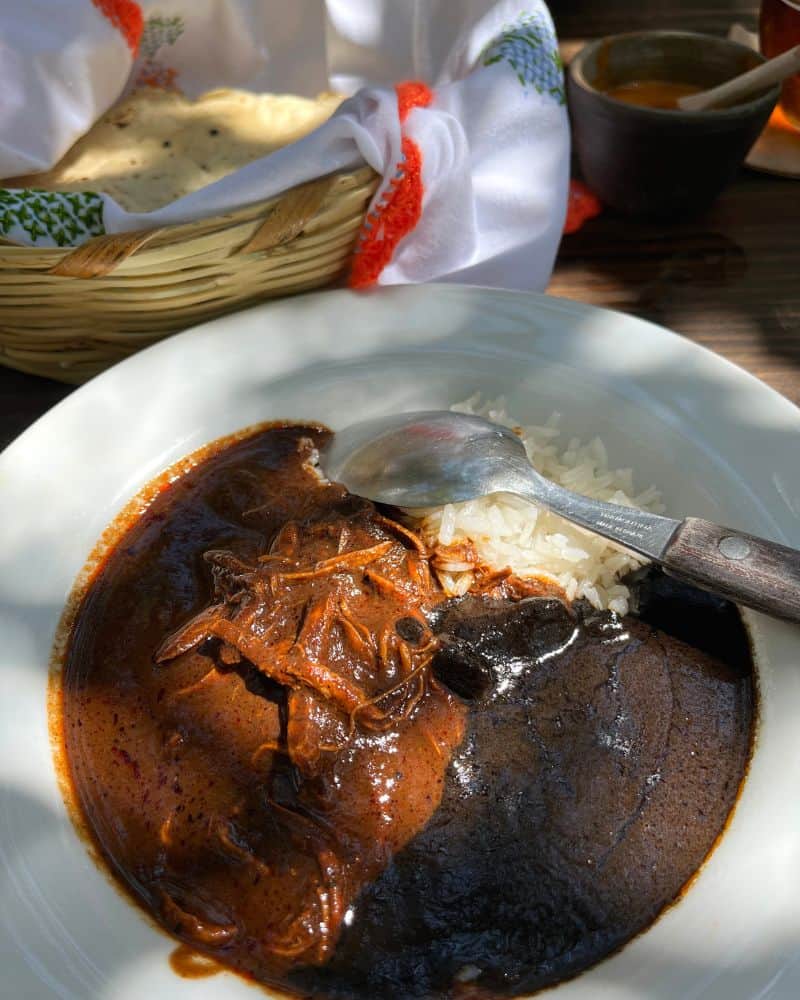
What is mole from Oaxaca?
Oaxaca mole is unique because it’s a a thick marinade paste, and also a sauce, a sauce and a full meal.
Mole is commonly served with rice and chicken or turkey, or used as a sauce, as with enmoladas.
This is a Oaxacan take on enchiladas, which are usually topped with salsa, but mole is used in Oaxaca.
Mole recipes vary, but in general, they consist of these flavors and ingredients: spicy chiles, acidic red or green tomatoes, sweet fruits and chocolate, local spices, and thickeners like nuts, seeds and even tortillas.
The ingredients are crushed and worked into a paste, then mixed with water or stock, and slow-simmered for hours, or even days, until thick.
You will find it in restaurants all over Oaxaca de Juarez (Note: This is the capital of Oaxaca state, though most refer to it as Oaxaca City or the City of Oaxaca).
🍽️ Seven Types of Oaxacan Mole

There are seven moles in Oaxaca, with varying combinations of spices, nuts, fruits, chiles and more. Some moles have up to 30 ingredients, though 12-15 is more common.
In fact, the word mole comes from the Nahuatl (Aztec language) word molli, meaning a concoction, or a sauce.
🤔 What is Oaxaca known for?
It’s the seven moles you’ll find below — and you really can’t even discuss Oaxacan Mexican cuisine without mentioning mole (pronounced moe-lay).
Mole is Mexico’s national dish, so it’s also made in other states like Chiapas and Puebla, which both border the state of Oaxaca.
WHERE IS THE BEST MOLE IN OAXACA MEXICO?
Everyone has their favorite spot when it comes to mole in Oaxaca. To eat with the locals, head to 20 de Noviembre Market or Mercado Benito Juarez Market, two of the best markets in Oaxaca.

Located in the Downtown Oaxaca City Center, there’s also the famous Fonda Florecita at Mercado de la Merced Market.
For an upscale dinner, head to Las Quince Letras for the mole sampler so you can try a few types at once.
My personal favorite place that I’ve had mole in Oaxaca was Mo-Kalli Oaxaca Restaurant.
It is definitely off the beaten path, but worth the trek, especially if you have a Oaxaca rental car.
2. Mole Negro (Black Mole)
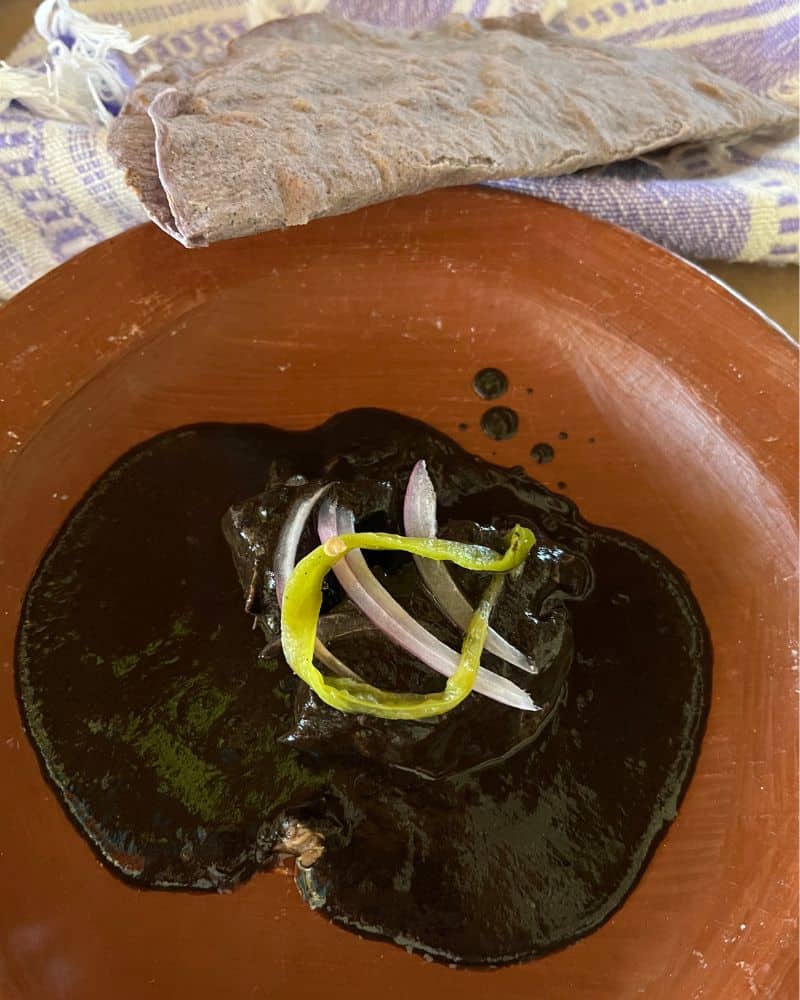
The most popular Oaxacan mole sauce is mole negro (Oaxacan black mole), which gets much of its black color from Oaxaca chocolate.
There are many other dark-colored ingredients in mole negro as well, like the black chilhuacle chiles, which helps give the dish a beautiful spicy-sweet balance.
You can find it in all the best restaurants in Oaxaca City, including the well known Casa Oaxaca Restaurant.
Mexican chef Alejandro Ruiz Olmedo owns and runs this Oaxaca foodie favorite, which is connected to the beautiful Casa Oaxaca Hotel, located in Centro Historico (Historic Downtown).
🍽🍷 Oaxaca Travel Tip: If you can’t get a reservation at Casa Oaxaca, head to its sister restaurant, Casa Oaxaca Cafe. Located about 15-minutes away by car, Casa Oaxaca Cafe has a near-identical menu.
3. Mole Poblano (Mole Rojo)

Mole poblano — AKA mole rojo, or red mole — is more associated with Puebla, Mexico than with Oaxaca, though you’ll find it in Oaxaca.
The word poblano in the dish’s name is a reference to the state of Puabla, and if you ever see Poblano cuisine referenced anywhere, that is also traditional Puebla food.
This red-colored mole has ingredients including mulato, ancho, and pasilla chiles, raisins, almonds and peanuts.
Mole poblano has a bold flavor, and is generally more sweet and more spicy than other traditional Mexican moles because it calls for a lot of chiles, dried fruits and nuts.
🥣 Mole Almendrado

One of the best variations on mole poblano is mole almendrado, which uses only almonds instead of a mixture of nuts.
You might also see this called mole estofado in Oaxaca.
Mole almendrado happens to be my personal favorite mole in Mexico, as I love almonds.
▶︎ Buy some here on Amazon and see for yourself how it stacks up for you.
4. Mole Amarillo (Yellow Mole)
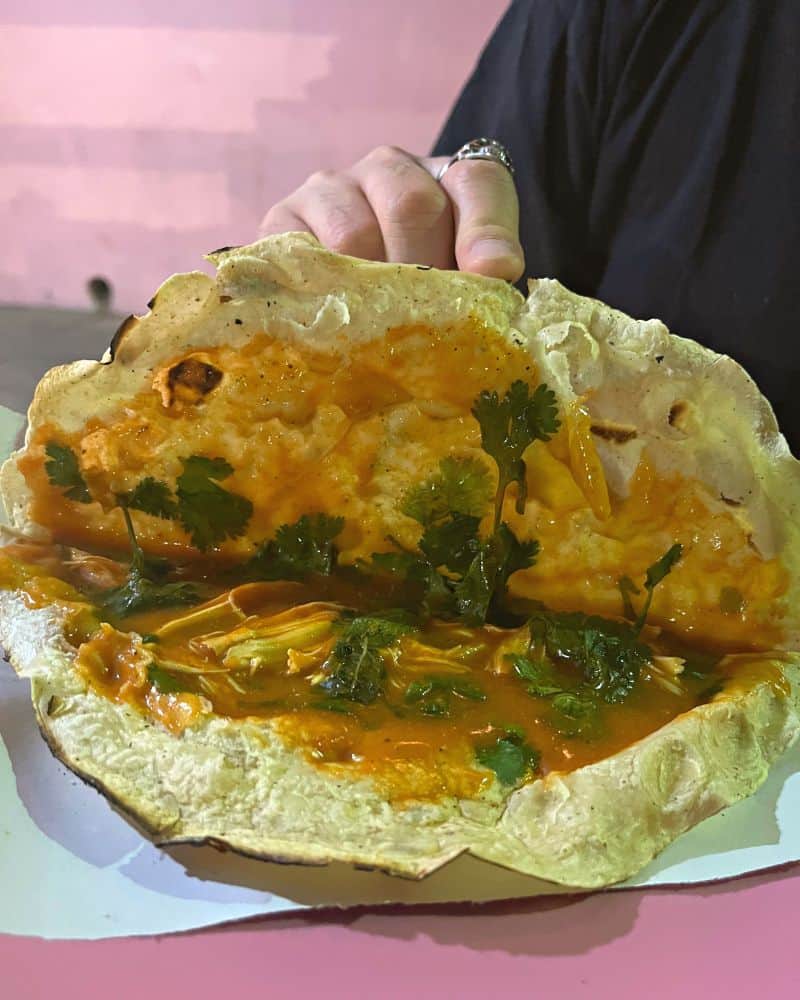
While you’ll often only find mole negro in restaurants, mole amarillo (yellow mole sauce) is the one Oaxacan mole you eat as a street food.
While visiting Oaxaca, Mexico, keep your eyes peeled for food carts and street vendors selling empanadas de mole amarillo (yellow mole empanadas).
You might also find it at Casa Oaxaca restaurant in Oaxaca City, Mexico.
🥟 What is an empanada? A type of handheld pie or turnover, often stuffed with meats, veggies and cheeses. They are among the most common Oaxaca foods, but eaten in many other countries, like Argentina and Colombia.
Oaxacan empanadas de mole amarillo are stuffed with shredded chicken in yellow mole sauce.
This bright yellow sauce gets its color from chilhuacle amarillo, a local yellow chili pepper from Oaxaca, Mexico.
5. Mole Verde (Green Mole)

Mole verde is a green mole that showcases all things green and local — including veggies, herbs and spices.
Unlike other foods of Oaxaca, this is a lighter dish, and in fact, is the lightest of all mole Oaxaca varieties.
Depending on who makes the mole verde, it can have a variety of different ingredients, like these:
- Tomatillos (green tomatoes)
- Nopal (cactus)
- Rajas (roasted poblano peppers)
- Pepitas (pumpkin seeds)
- Cilantro
- Jalapeños
- Parsley
- Epazote and hoja santa, two local Oaxacan herbs used in many dishes
6. Mole Colorado (Red Mole)

Mole colorado is a dark red colored mole.
As with all moles, ingredients can vary based on who’s making it, but some common mole colorado (red mole) ingredients include:
- Pasilla chili
- Ancho chili
- Chili de arbol (tree chili)
- Other peppers
- Nuts
- Cinnamon
- Chocolate — which helps give it a nice balance of savory, sweet and spicy flavor notes
🥣 Mole Coloradito

Similar to mole colorado, it is also a red mole, though lighter in color.
Mole coloradito, which means “little red mole,” and this Oaxacan recipe has more green-colored ingredients than mole colorado, which produces a softer red color.
Besides mole negro, mole coloradito is among the most popular moles in Oaxaca. You’ll have no trouble finding it on many of the Oaxaca restaurants’ menus.
7. Mole Manchamantel

Mole manchamantel isn’t one you’ll often see a menu at any of the best Oaxaca restaurants, make sure to try it.
Known as the “funeral mole,” it’s commonly only served at funerals, but some restaurants make it year-round.
Manchamantel means “tablecloth staining” because of the bright red chorizo sausage grease and ancho chile peppers, famous for permanently staining everything.
Besides the heavier pork and spicy chilies, mole manchamantel also has fresh pineapple and plantain (banana), making a sweet, spicy sauce.
8. Mole Chichilo

Chichilo mole is the thickest of the moles, thickened with masa harina (corn flour) or even crushed corn tortillas, making it more or a stew than a sauce.
It is unique in flavor because it is made with beef stock, anise, hojas de aguacate (avocado leaves), and chilhuacle, a black chili pepper.
9. Tlayudas

Tlayudas (pronounced tuh-lie-you-das) are the most beloved of all Oaxaca street food.
Note: You might see it misspelled as clayuda, but tlayuda is correct spelling for this beloved food Oaxaca has.
🤔 Wondering, What is a tlayuda? Well, they are often referred to as a Mexican pizza, because they do look like a pizza — though there’s no similarities in flavor to Italian pizza.
To make a tlayuda, you start out with a gigantic tortilla; larger than what you’d use for a burrito.
The tortilla is smeared with asiento (unrefined pork lard), and placed to toast over charcoal or a traditional cooking comal.
This large, flat cooking surface is used for many Oaxaca street food dishes.
After toasting the tortilla on the comal for a few minutes, refried beans, tomatoes, onions, shredded lettuce or green cabbage and avocado are placed on top, along with quesillo.
This is the famous Oaxacan string cheese, beloved throughout Mexico and beyond. It is a fresh cheese made by hand and then rolled into a ball.
After cooking for another few minutes, the tlayuda is folded into fourths, and the Oaxaca cheese continues to melt.
(Note: To really get the technique down, consider one of these best Oaxaca cooking classes.)
For those who want to add meat, it is usually just placed on top of the folded tlayuda. Most tlayuda shops offer tasajo, a dried jerky-style steak, and chorizo (sausage).
For the best tlayudas in Oaxaca, head to the local markets.
🍽️ When & Where to Eat Tlayudas in Oaxaca

Oaxacan tlayudas are traditionally a nighttime food.
While nowadays, as Oaxaca City’s tourism continues to grow, you can find shops selling them day and night, like Tlayudas El Negro and Tlayudas Libres.
If you can hold out, wait to join the locals for tlayudas after the sun goes down.
After dark, you’ll see vendors setting up small charcoal grills or comals outdoors.
There are numerous places to eat tlayudas street-side all over Centro Historico Oaxaca City, as tlayudas are to Oaxaca what pizza is to New York City.
Check out the “Oaxaca, Mexico” episode of Netflix’s Street Food: Latin America (Season 1, Episode 3) to see one of the most beloved places to eat tlayudas in Oaxaca City — Tlayudas La Chinita in Centro Historico.
10. Tamales Oaxaqueños

Tamales are eaten almost everywhere in Mexico, though tamales oaxaqueños (Oaxacan tamales) are made a bit different.
In Mexico, a tamal consists of a masa (corn) mixture, which is often covered in a salsa or sauce, and steamed to cook. This part is the same in Oaxaca.
After preparing the masa, Oaxacan chefs place the mixture in a plantain (banana) leaf, unlike the more commonly-used corn husk.
Throughout Oaxaca, you’ll often see tamales called tamales hojas (leaf tamales), as “hoja” is the Spanish word for leaf.
🫔 Cooked Oaxacan Tamales

There are a few kinds of savory Oaxacan tamales you’ll commonly find:
- Mole con pollo (chicken in mole negro, or black mole sauce)
- Frijoles (beans)
- Rajas (roasted poblano peppers)
- Chipil (a local Oaxacan herb, and one of the most common wild herbs used in Oaxacan cooking)
There’s also a dessert version called tamales dulces (sweet tamales).
This isn’t necessarily one of the more a traditional tamales in Mexico, but they are common in Oaxaca — where you might also see chocolate tamales.
Tamales dulces are often pink in color and made with sweet ingredients like whole fruit pieces of raisins, pineapple and frutos rojos (red fruits, or berries), fruit marmalades and shredded coconut.
Tamales are everywhere in Oaxaca City, but head to Mercado 20 de Noviembre (November 20th Market) to sample all the varieties in one place.
This traditional Oaxaca market has a food hall section, where you can go to different stalls and try a variety of tamales under one roof.
You’ll also find other unique things like pan de yema and caldo de piedra (stone soup).
11. Memelas (Memelitas)
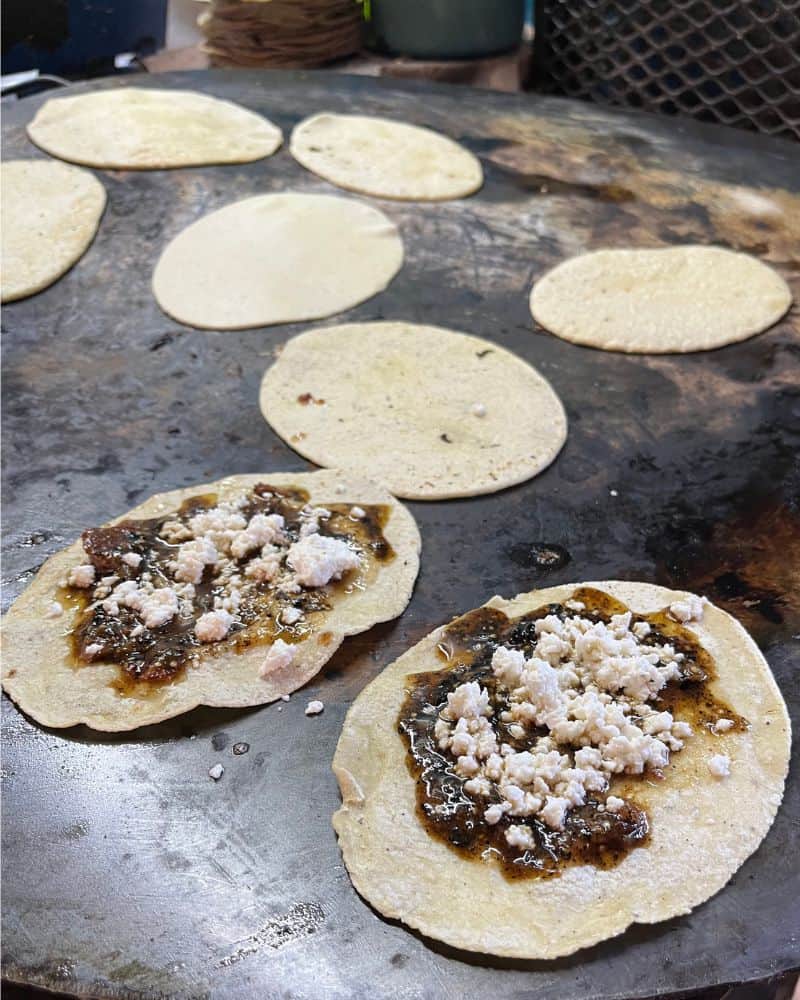
Memelas (pronounced mem-ell-uhs) are the most beloved Oaxaca antojitos. The word antojitos means “little snacks,” or appetizers.
You might also see or hear them called memelitas (little memelas).
Commonly eaten earlier in the day for breakfast and lunch, memelas are basically open face tacos, though they use a thicker tortilla, similar to that of a sope.
They are made on a cooking comal, and topped with all ingredients including Oaxaca cheese, refried beans, your choice of meat and salsa.
Memelas are the perfect grab and go snack, but locals also head to the Oaxaca mercados (markets) to eat them.
🤤 Memelas Doña Vale Oaxaca
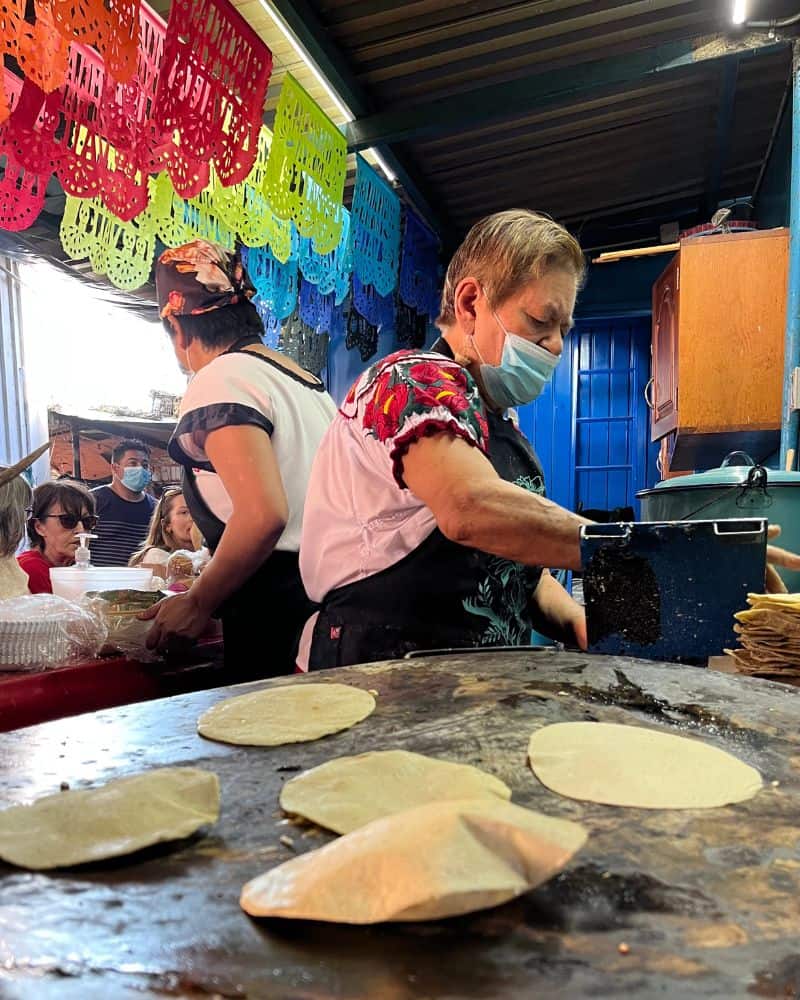
You can try memelas in markets all over the city, but there’s one place more popular than the rest.
In fact, some say t’s among the best places for memelas in Oaxaca, if not the best.
Memelas Doña Vale in Mercado Central de Abastos is a must-try on any Oaxaca City foodie tour; it was featured on the Netflix’s Street Food: Latin America show.
The chef and owner, Doña Vale (Ms. Vale), is known for her memelas and also her unique salsa morita.
This delicious, hand-made salsa uses chile morita, a smoked jalapeño pepper that’s similar in taste to a smoky chipotle.
12. Garnachas Istmeñas: Oaxaca Isthmus Cuisine

Garnachas look similar to a sope or memela, but are more commonly associated with traditional Istmeño Oaxacan cuisine.
This food comes from the Isthmus of Tehuantepec, located on the coast of Oaxaca.
There is a lot of seafood in Isthmian cuisine, and also similarities to Yucatan food from the Yucatan Peninsula.
Oaxaca state has eight regional cuisines, including comida istmeña (Isthmus cuisine).
You might also find garnachas in parts of Central America, particularly Belize and Costa Rica.
13. Tetelas

Tetelas (pronounced tet-tell-uhs) are triangular-shaped hand pies. For Oaxaca vegetarian foods, these will be a go to.
They are traditionally just stuffed with a black bean paste, a common Oaxacan black beans preparation, and quesillo string cheese.
Many tetelas also contain hoja de santa (holy leaf, or Mexican pepperleaf), a leaf from the pepper plant.
The hoja de santa leaf is used in many Oaxacan dishes, but gives tetelas a unique flavor among Oaxacan street food options.
Cooked over a traditional Mexican comal, tetelas are served hot so the quesillo (Oaxaca cheese) thoroughly melts within the triangular pocket.
Tetelas are easy to eat on the go as a Oaxacan street food, but head to Itanoni, a locals’ favorite, to try their amazing tetelas.
14. Enmoladas & Enfrijoladas

Enchiladas are one of the most popular Mexican foods, found throughout the entire country.
They are essentially tortillas stuffed with everything from beans and veggies to meat and cheese, plated and covered in salsa.
In Oaxaca, you can also find enmoladas, which are essentially enchiladas covered in a black bean sauce instead of salsa.
These are also found in other parts of Mexico, though enmoladas are more specific to just Oaxaca.
In fact, you might even hear them called enchiladas de oaxaca (Oaxacan enchladas). Enmoladas are enchiladas covered in a mole negro (black mole) instead of salsa.
As mole is the quintessential Oaxaca Mexico food, you’ll definitely want to try the enmoladas in Oaxaca, which make for a delicious breakfast or lunch food.
15. Carne Asada

No visit to Oaxaca is complete without checking out the Pasillo de Humo in Mercado 20 de Noviembre.
Pasillo de Humo translates to Smoke Hall or Smoke Alley, as this is where you come to enjoy grilled foods.
This lively section of the popular Oaxaca food market is filled with locals enjoying delicious grilled-to-order meats and veggies.
Some of the common Oaxaca meats you can sample at the mercado include:
- Tasajo: Thin beef steak, often salted and air-dried to cure, with a taste and texture somewhere between a steak and beef jerky
- Cecina: The same as tasajo, but with pork instead of beef
- Cecina enchilada: Cecina with chili powder
- Chorizo: Red sausage
Even non-meat eaters will enjoy the Oaxaca Pasillo de Humo, as you can buy roasted vegetables in a variety of Oaxacan sauce options as well.
Anything you get will have a yummy charcoal flavor, and will be grilled to order.
🔥 Pasillo de Humo in Mercado 20 de Noviembre

Perhaps the most famous place to eat in Mercado 20 de Noviembre Oaxaca, is the Pasillo de Humo.
This means smoke alley or smoke hall, but it also goes by other names like meat alley or carne asada hall.
Here, you’ll buy meat by the kilo (or half-kilo) that’s grilled to order.
The options change, but there’s usually always cecina (pork), tasajo (beef) and chorizo (sausage), among others.
Your meat is then served to you with fresh tortillas and various side dishes.
For a few pesos extra, you’ll definitely want to add sides like salsa, guacamole and chile de agua, grilled onions and chicharrón (pork rinds).
16. Queso Oaxaca Cheese (Quesillo)

In Mexico, queso oaxaca (Oaxaca cheese) is very well known, and it’s even gaining popularity in the U.S.
It is a string cheese that looks like a ball of fresh mozzarella, but has a saltier or more briny taste, similar to Monterey jack cheese.
When in Oaxaca, this cheese is referred to as quesillo (pronounced kay-see-yo), and not queso Oaxaca or Oaxacan cheese.
It is in many Oaxacan dishes, but to try some on its own head to any mercado (market) where you’ll find it sold by the kilo (1 kilo = 2.2 lbs).
As a string cheese, you’ll want to pull it apart for the best flavor.
17. Chapulines (Mexican Grasshoppers)

Eating chapulines (grasshoppers) dates back to prehispanic times.
These small insects are high in protein, fat-free and available for much of the year, so they were an integral part of the ancestral diet throughout Central Mexico.
Nowadays, you can try chapulines (pronounced chap-pull-lean-es) from vendors in Oaxaca mercados and street vendors.
They are sold by weight, placed into a bag for the customer, and eaten just like popcorn — with a similar crunchy and somewhat flavorless taste.
The chapulines are heated for a minute or two over a traditional cooking comal, then cooled prior to eating.
Some people have them plain, while others add toppings like lime juice, salt and spicy salsa.
You can also find chapulines served in guacamole, adding a crunchy texture.
Best Oaxaca Drinks
18. Tejate

Tejate (pronounced tay-ha-tay) is a centuries-old chocolate and corn drink.
While that flavor combo may not sound appetizing, this ancient drink has stood the taste test of time.
In fact, Oaxacans love tejate so much, they often call it the bebida de los dioses (drink of the gods).
Tejate is made by hand in large clay bowls, by liquifying a mixture of fermented cacao (chocolate) beans, toasted maize (corn), toasted pits of mamey (tropical fruit), and flor de cacao (cacao flower).
It is served cold, and very refreshing on a hot Oaxaca day.
Since it has been around since perhispanic times, each region, city and family will have their own unique tejate recipe.
However, even with variations, tejate generally tastes like a more complex chocolate almond milk.
19. Oaxaca Mezcal

Oaxacan mezcal is a distilled spirit that can be made from more than 30 varieties of the maguey (agave) plant.
If mezcal sounds like tequila to you — it kind of is.
Much like how champagne is essentially a sparkling wine from the city of Champagne, France, tequila is a kind of mezcal from the city of Tequila, Mexico.
If Tequila, Mexico, is the home of tequila, Oaxaca is the home of mezcal.
To show how much Oaxacans love their mezcal, there’s this common saying: Para todo mal, mezcal. Para todo bien, también. This means, “For everything good, mezcal. For everything bad, mezcal as well.”
In Oaxaca, mezcal comes served in a copita (mezcal cup), often with a plate of orange slices and sal de maguey (maguey worm salt).
This is the same worm that’s in a tequila bottle; though never a mezcal bottle.
Note: This beloved drink is meant to be sipped not taken as a shot. When you visit all the best Oaxaca mezcal bars, remember to sip!
In terms of flavor, mezcal tends to be a bit smokier than tequila, as it’s smoked underground in the fermentation process. However, not all mezcal has a smoky flavor.
The best mezcals come from Oaxaca, Mexico — like Ilegal Mezcal, Montelobos and 400 Conejos, Mexico’s best selling mezcal.
🥃 Best Oaxaca Mezcal Tours
One of the best things to do in Oaxaca, Mexico is take a Oaxaca mezcal tour at a Oaxaca distillery and see the entire mezcal process.
It starts with harvesting the agave, then smoking it underground, then distilling it, and finally, tasting the final product.
After you taste, you’ll be able to buy your favorite one.
20. Chocolate Oaxaquño (Oaxacan Chocolate)

Chocolate has been a staple food throughout Mexico since prehispanic times.
In Oaxaca, one of the top regions for cacao beans in Mexico, you’ll find it used more for hot chocolate than eaten straight up.
It’s also one of the main ingredients in mole, especially mole negro (black mole).
While in the U.S. it’s often prepared with milk, chocolate oaxaqueño (Oaxacan chocolate) is made with just chocolate and water.
It is still frothy like in the U.S. because this chocolate beverage is hand-spun using a wooden whisk called a molinillo, which creates a foam.
21. Aguas Frescas

Aguas frescas are fresh fruit waters, and you’ can’ll find them in almost all regions of Mexico.
Various fruits are used, as aguas frescas contain whatever’s abundant, and different indigenous groups may use fruits you’ve never heard of!
For a uniquely Oaxacan culinary experience, head to the Casilda Aguas Regionales stand in Mercado de Benito Juarez (Benito Juarez Market), one of the best Oaxaca markets.
22. Aguas Casildas

Opened in 1926 by the late Casilda Flores Morales, this famous spot is where the locals go for their aguas frescas — or aguas casildas, as they are sometimes known.
At this stand, make sure to try the chilacayote, a recipe that’s been passed down through the Casilda family for generations.
23. Agua de Jamaica (Hibiscus Tea)

Pronounced ha-my-kah, not Jamaica like the country, agua de jamaica is the most popular tea in Mexico.
Made from hibiscus flowers, and served over ice, it makes for a refreshing beverage in a hot country like Mexico. In taste, jamaica is tart, similar to cranberry or pomegranate juice.
24. Cafe de Olla
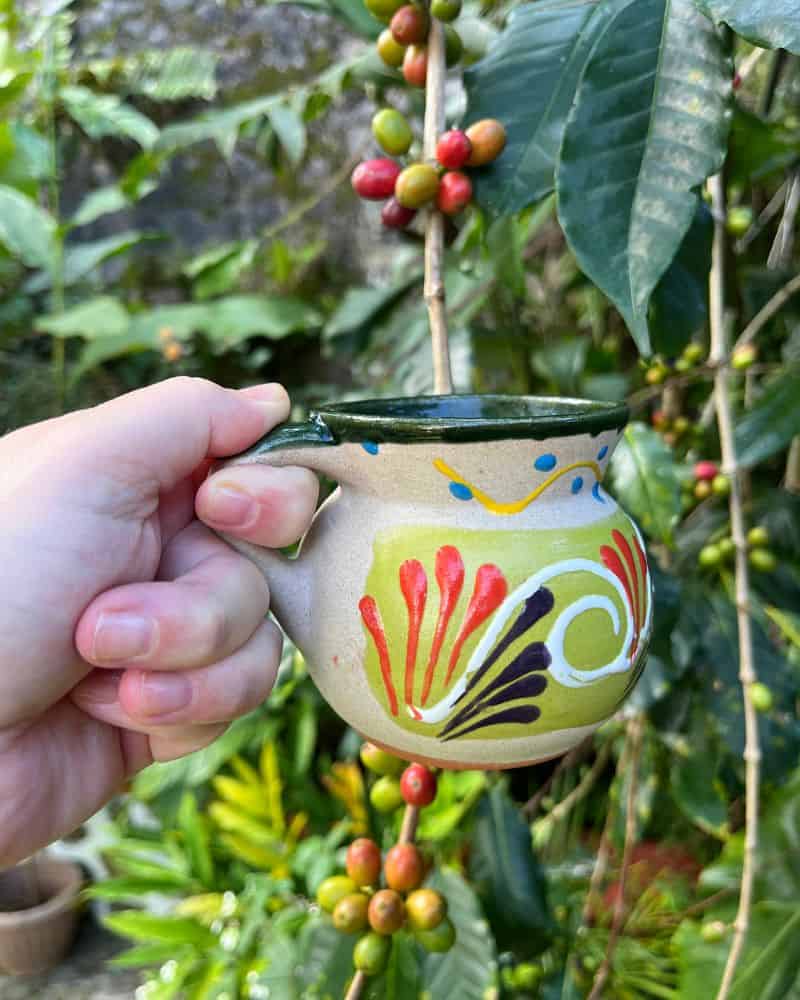
Cafe de olla is a traditional Mexican coffee preparation, common in Mexico’s more indigenous states, like Oaxaca and Chiapas. It is made in an olla (large clay pot) with cinnamon and piloncillo (raw cane sugar).
If you like your coffee sweet, you must try cafe de olla.
Oaxaca Spices, Fruits & Veggies
Now that you have a better idea of the overall foods and beverages you can enjoy in Oaxaca, below is a guide to some of the more unique ingredients in Oaxacan cooking.
25. Tuna Fruit

Tuna, pronounced like the fish, is also known as cactus fruit or prickly pear. As Oaxaca City is basically a desert in the Sierra Sur Mountains, you can find cacti and tuna all over.
Try this colorful fruit in ice cream or nieves (half-ice cream, half-slushy) — the perfect treat on a hot day in Oaxaca Mexico.
26. Huitlacoche (Corn Fungus)

Huitlacoche (pronounced wheat-la-co-chay) is a corn fungus, sometimes called corn smut, corn mushroom or “Mexican truffle.”
It has an earthy, mushroom taste, similar to a truffle, but less fragrant. Though an acquired taste, those who love huitlacoche just can’t get enough of it.
The best time to visit Oaxaca Mexico to sample fresh huitlacoche is in summer, during the rainy season.
27. Epazote
This is one of the most commonly used aromatics in Oaxacan and Mexican food throughout the country.
On its own, epazote isn’t very good, but when used in cooking it adds a big flavor punch giving off hints of oregano, mint, pepper and even citrus.
28. Flor de Calabaza (Squash Blossom)

Flor de calabaza, AKA cactus blossom, squash blossoms, or squash flower is the flower from we get the zucchini. If you didn’t already know, zucchini is a type of squash.
These edible flowers are popular in Oaxaca vegetarian restaurants, where you can try a yummy flor de calabaza quesadilla with Oaxaca cheese.
29. Hoja Santa (Mexican Pepperleaf)
Besides epazote, you’ll find hoja santa in many traditional Oaxaca food dishes.
Hoja santa transaltes to “saint’s leaf” or “sacred leaf,” though you’ll often hear it called Mexican pepperleaf in English.
As the name states, this is a peppery-tasting leaf, though it also has a minty flavor.
30. Nopal (Cactus)

Nopal means cactus in Spanish, and this is one of the most beloved veggies to cook in much of the country, especially Central Mexico.
As one of the most abundant natural plants, it only make sense cactus is one of the best traditional Mexican foods, and eaten throughout Oaxaca.
31. Jicama
Jicama (pronounced hick-uh-ma) is a white colored veggie, native to Mexico and South America.
It has a slightly sweet, nutty flavor, similar to a Chinese water chestnut, but with more of a pear-like texture.
Jicama is a common snack in Oaxaca and Mexico, often served like a veggie lollipop and sold by street vendors.
You’ll find it served like this in other parts of Southern Mexico and Central Mexico as well, including Mexico City.
You’ll get a large slice of jicama on a stick doused in lime juice with some yummy Tajín spice powder sprinkled over it.
Best Oaxaca Cookbooks
If you can’t leave the United States to experience the food in Oaxaca Mexico in person, pick up one of the Oaxacan cook books.
They are the next best thing to understand traditional Oaxacan food!
Among the best ones, check out The Food of Oaxaca Cookbook, Oaxaca: Home Cooking from the Heart of Mexico and Oaxaca al Gusto: An Infinite Gastronomy.
Both Mexico cookbooks and Oaxacan food cookbooks make an amazing Mexico gift for the foodie in your life who wants to make Oaxaca recipes at home. 📚 Love books? Check out these 35 Best Books on Mexico.
Best Oaxaca Food Tours
The most fun way to experience and enjoy Mexican Oaxacan food is with a local to guide you to all the best food in Oaxaca City, and all the hidden gems in this foodie town!
If you’re traveling to Oaxaca soon, check out these amazing Oaxaca food tours.
You haven’t had real Mexican food unless you’ve had food that’s made in Mexico — and who better to show you all the best spots than a Oaxaca local.
If you don’t want to be stuck at the tourist traps, book a Oaxaca Mexico food tour.
Final Thoughts: Best Oaxaca Foods and Oaxacan Drinks
This list just scratches the surface of all the delicious food to try in Oaxaca, Mexico!
However, it definitely highlights that there’s more to Mexico than just tacos — though Mexico tacos are undoubtedly the best on Earth.
Oaxaca cuisine is still very much connected to its deep, prehispanic roots. It is among the best traditional food in the world.
The state itself is charming, well known for the Oaxaca Day of the Dead celebration, but also as an off the beaten path Mexico foodie destination, fast becoming one of the world’s culinary meccas.
Wondering, How safe is Oaxaca Mexico? For the majority of travelers, it’s perfectly safe.
However, safety is a complex subject, so head to this article for a deep dive — Is Oaxaca Safe to Visit Right Now?




